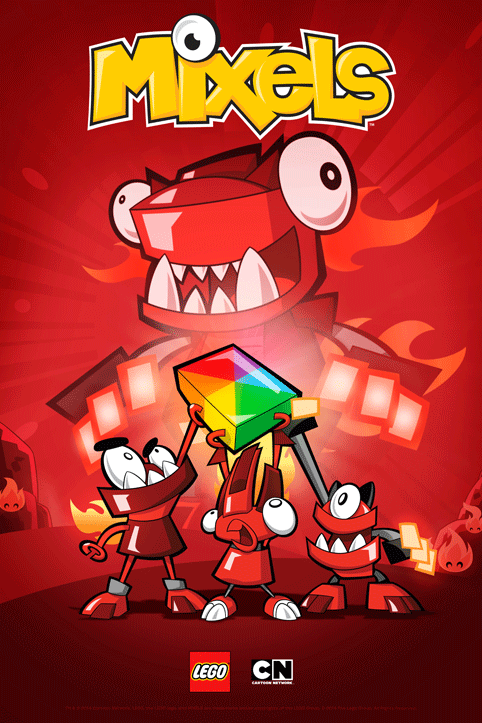Cartoon Network’s Michael Ouweleen on designing for children
Michael Ouweleen joined Cartoon Network back when it had just 50 employees, and now holds the position of Cartoon Network and Adult Swim senior vice president executive creative director. He heads up the in-house ad agency at Cartoon Network, dubbed its Creative Group, and has helped the brand become one of the biggest channels in the US – it claims to reach 100 million American homes. Ouweleen was also responsible for co-creating the series Harvey Birdman in Attorney at Law for Cartoon Network’s sister channel Adult Swim. The peculiar series uses Hanna-Barbera-created characters, which star as staff in the Sebben & Sebben law firm. As you can imagine, hilarity ensues. His latest project is the interactive kids’ site Mixels.com, a partnership with Lego. We spoke to him about designing for an ever-sophisticated children’s’ market; the challenges faced by traditional animation studios in the face of youthful internet start-ups and how wannabe-cartoonists should go about starting their careers.

Design Week: How did you start out in design?
Michael Ouweleen: I won my first job by answering eight questions in a full-page ad in the New York Times. J.Walter Thompson was running a Write if You Want Work competition and I won a job.
DW: What influences you?
MO: You have to be curious about everything going on. New music, new design, new fashion, new, new, new. What helps me with this is that I have three sons that are into all the same stuff that I am, so all of our conversations at home are about art and culture and gaming and music and cosmology and technology and philosophy and—it’s amazing. I’m not kidding. Then, you also have to be sure to be rooted in fundamentals and traditions of design and culture, so that you aren’t swept away in the nanosecond trending of today’s culture.
DW: How would you describe the look and feel of your work for ad creative on Cartoon Network?
MO: Hopefully smart and funny. This network could have easily been all noise and tilted type and loud sound effects, what people think of when they generically think of ‘cartoon’ or ‘kids’. We’ve tried to, over the past 17 years, let the creative excellence of the actual cartoons and characters inform the network, and make smart, surprising work.
DW: And your work on Adult Swim?
MO: I did the first three or four years of creative directing for Adult Swim and back then the charge was to create separation from Cartoon Network. Which we did by putting old people in swimming pools on the screen. I’m now working more directly on Adult Swim than I have since those days, and I think there’s such a great tone of voice with the brand overall, the immediacy and transparency of what we now call Twitter was what Adult Swim was doing ten years earlier. That’s the overall brand promise of Adult Swim now, talking to the audience like humans. I’m doing everything I can to help grow that.

DW: Can you tell me more about your role on Harvey Birdman?
MO: I was actually co-creator, co-executive producer. Erik [Richter] and I came up with maybe four ideas for shows that the network could do as a follow up to Space Ghost Coast to Coast. They sat around for years, until Adult Swim got green-lit. Suddenly, there was a need to brand a new block and create content for it. So I was creative directing the branding and trying to build a show at the same time. We had lots of false starts getting that show into a pattern of production, which was frustrating, and I always had a full-time day job during it. It was a small writing staff, me and Erik and some people around the network that would help out for fun. We oversaw every aspect of it creatively. And again, this was in addition to whatever other job I was doing at the time— creative director, or towards the end, overseeing development and programming for Cartoon Network. It was an amazing experience. Working with great show unit talent and an incredible cast (Gary Cole, Stephen Colbert, Peter McNicol, John Michael Higgins, Mo LaMarche).
DW: How did the partnership with Lego come about for Mixels?
MO: Our chief content officer, Rob Sorcher and Tramm Wigzell (a vice president of development) were visiting Lego in Billund, saw these little creatures sitting around and said ‘Oh wow! We should do something with these guys!’ And in very short order, with Lego, they constructed a whole new way for a property to be developed— shorts, a game, toys, etc. My group jumped in to help design the overall brand look for the property and help create marketing materials that tied all the wide-ranging elements (2D animation, a 3D game, toy packaging, some consumer products) together.

DW: How have what children expect from television changed in the last 20 years?
MO: They’ve grown up with several networks trying to cater to their taste. They’ve grown up with content being available to them at any time in any place. They have grown up seeing their favorite characters expressed in different ways all at the same time. But the fundamentals what they are really looking for in all of that hasn’t changed. It all still comes down to great characters that they can laugh at, characters that surprise them.
DW: How do you ensure you keep them interested in the brand?
MO: We have to balance being who we are, and what as a network we are good at, with who they are, and what their thoughts and ways of being are. We have to bring something uniquely Cartoon Network to the conversation, but make sure that what we’re saying isn’t hitting their ear falsely.
DW: How has the internet and technology changed the considerations in designing for children?
MO: You have to up your game. When I was a kid I saw maybe three interesting images a week and you’d have two or three really big images a year. And now kids are just—flick, flick flick—going through amazing images one after another. They see hundreds a day; they spend a split-second on each. They know what’s good.
DW: For the Adult Swim audience, there must be a lot of competition from online animators who can upload content daily, which can be accessed for free. How do you view that? And how do you work around that competition?
MO: Animation is HARD. Even though technology has made it easier, it’s very labour-intensive and still very hard to get right and make it funny. It’s hard to put out quality animation in any real volume. What Adult Swim does really well, something I can take no credit for (but have benefited from in making Harvey Birdman) is find good people it believes in and then give them the opportunity, space and just the right amount of guidance to make something unique and great. In that way, I think Adult Swim has a leg up on the internet.
DW: How do you think the Adult Swim brand translates to a UK audience?
MO: I should think it would mostly translate well. It certainly wouldn’t need much dubbing. And many, if not most of the people involved with Adult Swim cite British comedy as their main influence, both growing up and now.
DW: What advice would you give to people who want to go into animation?
MO: Can you draw? If so, get drawing and putting your work out there and go to a good school for animation as soon as it’s legal. Can you not draw but can write? Then get yourself as good an education as you can muster and practice funny writing. And either way, watch everything you can, read Chuck Amuck, read the Maurice Noble book, read books on story or character and screenwriting, ready interviews such as this, filled with pithy advice, and then march into some office and demonstrate your passion for this stuff.
-
Post a comment




